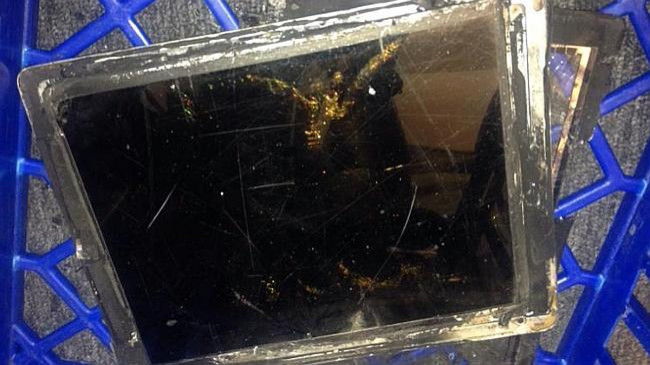Apple iPad Air Explodes: Why The ‘Burst Of Flames’ Was Likely A Charger Issue, Not An iPad Problem

The iPad Air may be the hottest Apple device right now, and a number of Vodafone customers and employees in Australia would likely be inclined to agree after what they witnessed late last week. According to a Vodafone spokesperson, a Vodafone store in Canberra was evacuated last week after a “burst of flames” reportedly shot out of a charging port connected to a demo model of the new iPad Air.
A local fire brigade eventually showed up to see the Vodafone store filled with smoke, as sparks were continuing to shoot out of the iPad Air charging port. No customers or Vodafone employees were injured during the incident, and Apple reportedly sent a representative to the store to collect information about the device to find out what caused the explosion. Apple has yet to offer an official comment on this story.
In all likelihood, the iPad Air explosion was likely caused by a faulty charger, rather than a malfunction or defect within the iPad itself. Over the last several years, there have been many reported cases of Apple devices spontaneously combusting as a result of faulty and unauthorized third-party chargers. In July, a 23-year-old Chinese flight attendant was killed via electric shock when answering a call on her iPhone, and a week later, a 30-year-old Chinese man fell into a coma after he was shocked by his iPhone 4 still connected to its charger. In both cases, Apple determined that the cause was a faulty third-party charger, and the company soon introduced a USB power adapter takeback program to trade in poorly designed and unsafe counterfeit chargers and adapters for safe and reliable chargers built by Apple.
“Knockoff chargers sometimes cut corners,” telecommunications expert Xiang Ligang told CCTV. “The quality of the capacitor and circuit protector may not be good, and this may lead to the capacitor breaking down and sending 220 volts of electricity directly into the cell phone battery.”
Tangfan Wei, an authorized engineer for Apple parts, said an iPhone charger normally reduces China’s 220V working voltage to about 5V, which is much lower than the 36V of electricity the human body can withstand. However, unauthorized Apple chargers may be prone to conduction issues, which could result in electric shocks in excess of 220 volts.
"Customer safety is a top priority at Apple," the company said in a statement detailing the USB takeback program. "That’s why all of our products — including USB power adapters for iPhone, iPad, and iPod — undergo rigorous testing for safety and reliability and are designed to meet government safety standards around the world."
About The iPad Air
The 9.7-inch iPad Air brings the first major design change to the iPad since the March 2011 release of the iPad 2. The new iPad Air better resembles its “mini” counterpart, with its thinner side bezels, symmetrical speaker grilles, aluminum unibody and less-tapered back for a better grip. As we mentioned, this form factor weighs just 1 pound.
Besides the A7 chip, which runs up to twice as fast as last year’s A6X chip featured in the 2012 release of the iPad 4, Apple also chose to release the iPad Air with the company’s new M7 co-processor, which helps offload motion-based sensors from the A7 but is likely featured to give the chip a test-run before it powers Apple’s upcoming iWatch.
The iPad Air also comes with two new cameras: While the iPad 4 featured a 1.2-megapixel FaceTime HD camera with 720p HD video and a 5-megapixel rear-side camera with 1080p HD video, Apple tweaked both cameras in the iPad Air, opting to release the iPad Air with the same 5-megapixel camera with larger pixels (similar to the iPhone 5s) and a slightly improved 1.2-megapixel FaceTime HD camera with 720p HD video.
The iPad Air from Apple also comes with faster Wi-Fi and more LTE bands on the cellular model, but both iPad Air models (Wi-Fi and Wi-Fi + cellular) will come in two color options: white with silver, and space grey with black. The basic iPad Air with Wi-Fi starts at $499 for 16 GB and ranges up to $799 for 128 GB. For an iPad Air with Wi-Fi and LTE, models start at $629 for 16 GB and range up to $929 for 128 GB.
For more about the iPad Air, read our thorough review of the fifth-generation iPad, read our three reasons why the iPad Air may disappoint you, and be sure to sound off in the comments section below.
© Copyright IBTimes 2024. All rights reserved.






















